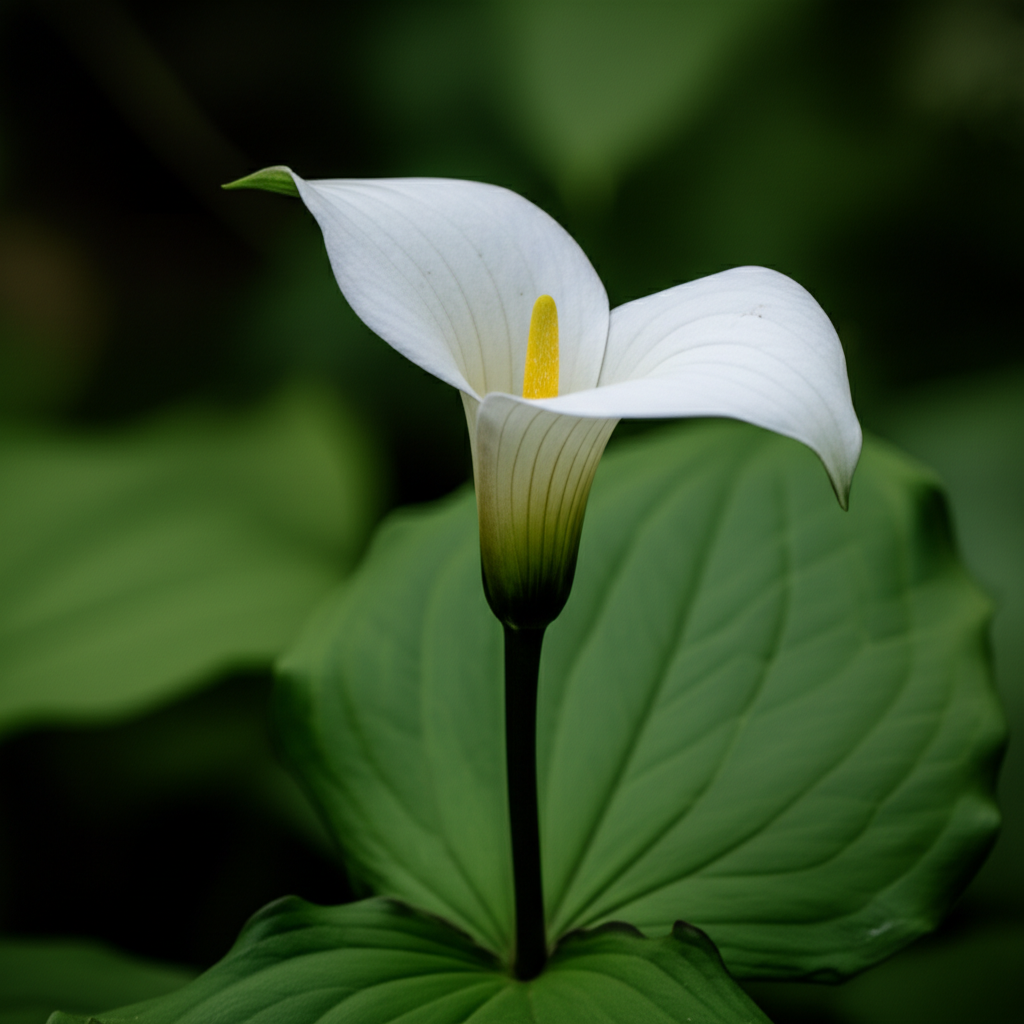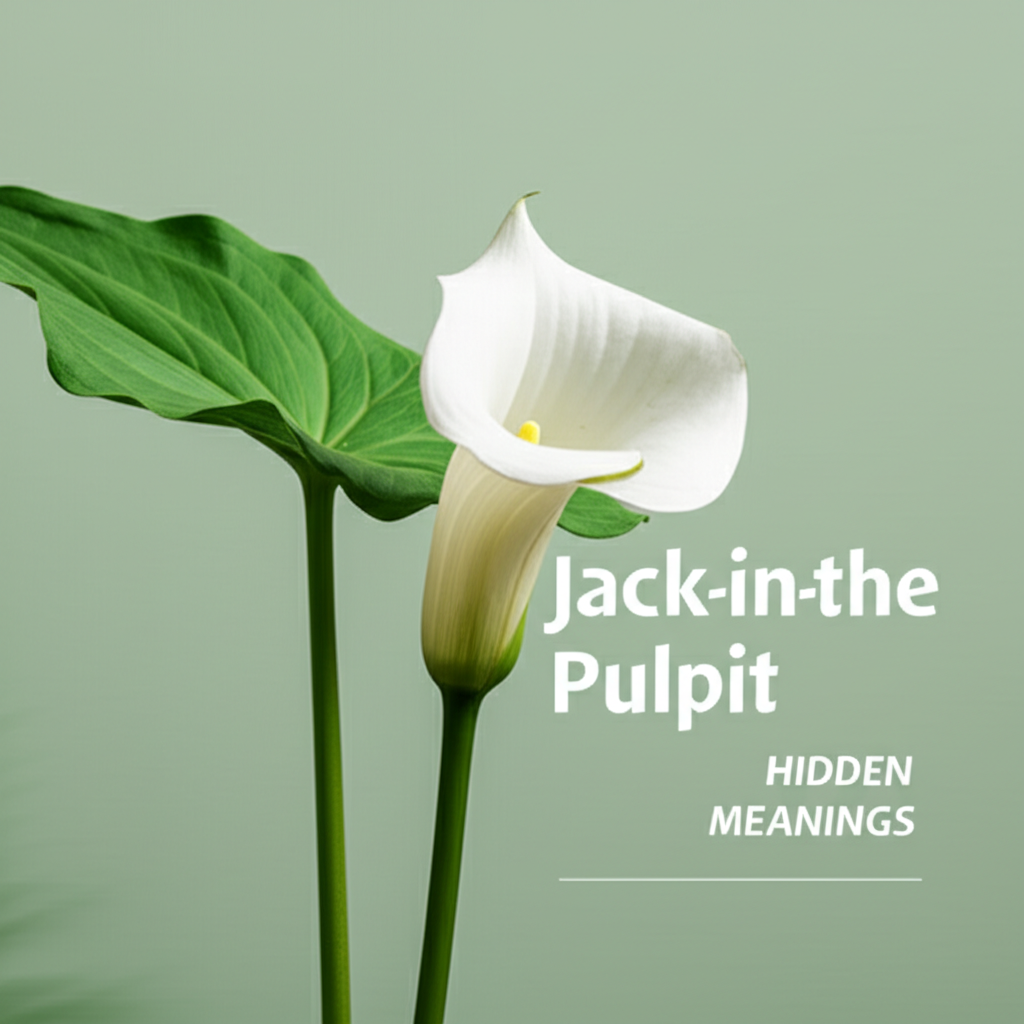The Jack-in-the-Pulpit: More Than Just a Curious Bloom
The Jack-in-the-Pulpit (Arisaema triphyllum) is a plant that immediately captures attention. Its unique, hooded spathe that encloses a club-like spadix creates an image evocative of a preacher standing in a pulpit, hence its common name. This distinctive morphology has not only fascinated botanists but has also deeply resonated with poets, writers, and storytellers throughout history. The flower’s intricate structure and its often-hidden nature contribute to a rich tapestry of symbolism, weaving its way into literature as a representation of duality, transformation, hidden power, and even moral ambiguity.
The plant itself is a marvel of nature. It typically grows in moist, shaded woodlands of eastern North America, unfurling its leaves and flower in the spring. Its reproductive structures are concealed within the spathe, a mechanism that attracts pollinators while protecting the delicate inner workings. This inherent secrecy and layered complexity provide fertile ground for literary interpretation.
A Brief Botanical Overview: Understanding the Structure for Deeper Meaning
Before delving into its literary significance, a basic understanding of the Jack-in-the-Pulpit’s anatomy is crucial. The “pulpit” is the spathe, a modified leaf that curls to form a hood, often striped with green, purple, or brown. Inside this protective casing is the “Jack,” the spadix, a fleshy spike covered in tiny flowers. This ingenious design allows for efficient pollination, as insects are guided into the spathe to reach the flowers, and then exit through a specific opening, carrying pollen with them.
The plant also exhibits a fascinating sex-changing ability, a phenomenon known as sequential hermaphroditism. Most plants are initially male and, as they mature and accumulate resources, can transition to becoming female. This biological characteristic further fuels interpretations of transformation, adaptability, and the fluid nature of identity.
Key Symbolic Meanings of the Jack-in-the-Pulpit

The visual distinctiveness and biological peculiarities of the Jack-in-the-Pulpit have led to a range of symbolic interpretations across different literary contexts. These meanings are often intertwined, creating a nuanced and multi-layered understanding of the plant’s presence in a narrative or poem.
Duality and the Hidden Self
Perhaps the most prominent symbol associated with the Jack-in-the-Pulpit is duality. The stark contrast between the external, often plain or subtly colored spathe, and the potentially vibrant inner spadix mirrors the human experience of presenting a certain face to the world while harboring a different, perhaps more complex or passionate, inner life. This can represent:
- The outward appearance versus inner reality.
- The public persona versus the private self.
- The benevolent facade concealing a darker truth, or vice-versa.
The “preacher” within the “pulpit” can be seen as a symbol of authority or pronouncements, but the enclosure suggests that this pronouncement is not entirely open or universally accessible. It implies a contained truth, a message delivered from a specific, perhaps privileged, position.
Transformation and Metamorphosis
The plant’s ability to change sex is a powerful metaphor for transformation and metamorphosis. This can be applied to characters undergoing personal growth, spiritual awakenings, or significant life changes. The transition from male to female symbolizes:
- Adaptability in the face of changing circumstances.
- The fluid nature of identity and gender.
- The process of becoming, evolving, and shedding old forms.
This symbolism is particularly potent in coming-of-age stories or narratives exploring the shedding of old beliefs and the adoption of new ones.
Hidden Power and Unseen Potential
The concealed reproductive organs within the spathe suggest hidden power and potential. The plant may appear unassuming from the outside, but it possesses the vital mechanism for reproduction and continuation of its species. This translates in literature to:
- The quiet strength of an individual underestimated by others.
- The untapped potential residing within seemingly ordinary circumstances.
- The power of subtle influence or behind-the-scenes action.
The “Jack” is powerful, but only revealed when conditions are right or when observed closely. This speaks to the value of looking beyond surface appearances to discover true strength.
Moral Ambiguity and the Sacred vs. the Profane
The striking visual of a figure standing in a pulpit can also evoke religious imagery. However, the Jack-in-the-Pulpit is not a purely divine or sacred symbol. Its often earthy nature, its growth in damp, shaded areas, and its sometimes somewhat grotesque appearance when viewed up close can introduce an element of the profane or the morally ambiguous. This duality can represent:
- The struggle between good and evil.
- The blurred lines between religious doctrine and earthly desires.
- The idea that wisdom or truth can be found in unexpected, even unsettling, places.
The “preacher” might be delivering a sermon, but the “pulpit” is made of earth and leaves, grounding the spiritual in the material.
Seclusion and Mystery
The way the spathe enfurls the spadix creates a sense of enclosure and mystery. This can symbolize:
- Secrets kept closely guarded.
- The allure of the unknown.
- Periods of introspection or withdrawal.
The plant invites curiosity, but its inner workings are not immediately apparent, mirroring situations where understanding requires patience and deeper investigation.
| Aspect | Botanical Feature | Literary Symbolism | Related Concepts |
|---|---|---|---|
| Structure | Hooded spathe enclosing spadix | Duality, hidden self, outward appearance vs. inner reality | Disguise, internal conflict, the sacred vs. the profane |
| Reproduction | Sex change (sequential hermaphroditism) | Transformation, metamorphosis, adaptability | Growth, evolution, fluidity of identity |
| Habitat | Shaded, moist woodlands | Seclusion, mystery, the hidden | Introspection, secrets, the subconscious |
| Appearance | Unique, often striped or mottled spathe | Hidden power, potential, understated strength | Underestimation, inner reserves, quiet influence |
The Jack-in-the-Pulpit in Literary Works
While not as ubiquitous as roses or lilies, the Jack-in-the-Pulpit has appeared in a variety of literary works, often contributing a specific mood or thematic layer. Its presence is frequently subtle, a vivid detail that enriches the reader’s understanding of character, setting, or plot.
Poetry: Evoking Atmosphere and Emotion
In poetry, the Jack-in-the-Pulpit is often employed for its evocative imagery and its capacity to suggest complex emotions without explicit declaration. Poets might use it to capture the essence of a specific season, a particular mood, or to imbue a natural scene with deeper meaning.
- As a symbol of spring’s subtle emergence: The Jack-in-the-Pulpit is an early spring bloomer, appearing as the forest floor begins to awaken. Poets might use it to represent the tentative beginnings of hope, new life, or a quiet resurgence after a period of dormancy.
- To represent enclosed beauty or hidden feeling: The sheltered nature of the flower can be a metaphor for feelings that are not openly expressed, or for a quiet beauty that is only appreciated upon closer inspection.
- In connection with folklore and myth: Due to its unusual appearance, it can sometimes be linked to folklore about fairies, spirits, or hidden realms, adding a touch of the mystical to a poem.
Prose: Character Development and Setting Enhancement
In prose, the Jack-in-the-Pulpit can serve as a potent symbol for characters or for enhancing the atmosphere of a setting.
- Characterizing the Understated: A character who is described as being like a Jack-in-the-Pulpit might be someone who appears unassuming but possesses hidden depths, intellect, or a strong will.
- Setting a Tone of Mystery or Foreboding: The plant’s association with shaded woods and its somewhat unusual appearance can lend an air of mystery or even unease to a descriptive passage.
- Illustrating Themes of Transformation: If a character is undergoing significant change, the Jack-in-the-Pulpit might be used as a subtle parallel to their internal journey.
Literary Examples and Interpretations
Specific instances of the Jack-in-the-Pulpit appearing in literature, though sometimes subtle, offer tangible examples of its symbolic use. Analyzing these instances allows for a deeper appreciation of its literary impact.
“The Jack-in-the-Pulpit” by Robert Frost
Robert Frost, a poet deeply attuned to the natural world, famously wrote a poem titled “The Jack-in-the-Pulpit.” In this poem, the flower is personified, and its unique structure is explored through a dialogue between the speaker and the flower itself. Frost uses the plant to discuss themes of honesty, humility, and the importance of inner substance over outward show. The flower’s refusal to sing or preach until its “audience” is ready can be interpreted as a commentary on the nature of authentic communication and the timing of revelation.
“A Chapter of the Flowers” by John Burroughs
Nature writer John Burroughs, in his essays, often mused on the symbolic qualities of various plants. While he may not have dedicated a specific work solely to the Jack-in-the-Pulpit, his observations on its “shy” and “modest” nature, coupled with its “peculiar structure,” would have lent it to interpretations of concealed beauty and quiet strength. He would likely have appreciated its biological ingenuity as a reflection of natural wisdom.
Regional Folklore and Indigenous Interpretations
While not strictly “literature” in the Western canon, the folklore and traditional knowledge of Indigenous peoples of North America, where the Jack-in-the-Pulpit is native, often imbue plants with deep spiritual and symbolic meaning. In some traditions, the plant is associated with healing, protection, or as a marker for certain spiritual sites. Its common name among some tribes, such as “Indian Turnip,” reflects its practical uses but also hints at a connection to the earth and its mysteries that transcends mere sustenance.
| Step | Description | Pros | Cons |
|---|---|---|---|
| 1. Identify the Presence | Note instances where the Jack-in-the-Pulpit is mentioned or described. | Establishes the foundation for analysis. | May be subtle or easily overlooked. |
| 2. Examine the Context | Analyze the surrounding text: Who is observing it? What is happening in the narrative? What is the mood? | Provides crucial clues to the intended meaning. | Requires careful reading and understanding of literary devices. |
| 3. Consider Botanical Traits | Relate the plant’s physical characteristics (structure, habitat, sex change) to potential symbolic meanings. | Connects the literal to the figurative. | May require some basic botanical knowledge. |
| 4. Interpret the Symbolism | Formulate potential meanings based on context and botanical traits (duality, transformation, hidden power, etc.). | Leads to a deeper understanding of themes. | Interpretation can be subjective; multiple meanings are possible. |
| 5. Connect to Themes | Determine how the symbolism of the Jack-in-the-Pulpit contributes to the overall themes and messages of the work. | Enhances appreciation of the author’s craft. | Requires synthesizing various analytical points. |
Modern Interpretations and Enduring Appeal
In contemporary literature, the Jack-in-the-Pulpit continues to hold its symbolic weight. Its unique form lends itself to exploring themes that remain relevant:
- Identity in Flux: In an era where discussions around fluid identities are prominent, the plant’s natural sex change offers a compelling metaphor for personal evolution and the rejection of rigid categories.
- The Unseen and Undervalued: The Jack-in-the-Pulpit’s quiet presence in overlooked woodland corners can resonate with narratives about marginalized individuals or suppressed voices striving for recognition.
- Ecological Awareness: As environmental concerns grow, the Jack-in-the-Pulpit, as a native woodland plant, can symbolize the importance of biodiversity, fragile ecosystems, and the hidden wonders of the natural world.
The enduring appeal of the Jack-in-the-Pulpit in literature stems from its inherent enigmatic quality. It is a plant that doesn’t shout its meaning; rather, it invites contemplation. Its visual intrigue, combined with its fascinating biological adaptations, provides writers with a rich lexicon of symbolism. Whether used to represent the complex inner lives of characters, the transformative power of nature, or the subtle forces at play beneath the surface of reality, the Jack-in-the-Pulpit remains a potent and captivating element in the literary landscape. It serves as a reminder that true meaning is often found not in the obvious, but in the carefully concealed, the subtly presented, and the profoundly transformed.


